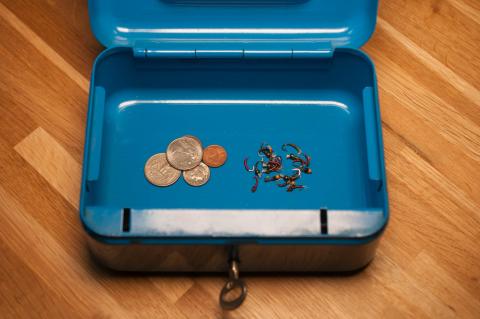Recent comments
@flytyer57
Why do you think I started this Thunder & Lightening discussion? A demonstration of how smart I am? I guarantee you that the answer is NO! I don't think I need to prove anything to you. ... and then I ask you again, why? I was waiting for a concrete reaction from you, which would materialize in something visible, but maybe you didn't understand why I commented. Maybe now you understand that I tried to suggest something with my intervention. :)
- Log in to post comments
Tom,
It was an offer I couldn't resist as it's said in a famous film...
When Darren reached out there wasn't much doubt in my mind, and even though the conversion was a fairly tough job, the result is great, and a valuable resource is preserved online.
Martin
- Log in to post comments
Hello Martin: I think this is wonderful that you undertook this colossal merger and helped preserve all this beautiful information and keep it accessible for all of us. Thank you very, very much!
Tom
- Log in to post comments
Dan,
I have no idea where to find Trevor Morgan's Javelin lines these days. I have lost contact with him many years ago, and can't find anywhere online where they are sold.
Sorry to be of so little help, but it seems like a dead end.
Martin
- Log in to post comments
I have a Trevor Morgan 7 wt single hand line and because I used it to cast bigger flies into a new area code, I started popping sections of my running line. I lone this line a lot. It lasted a really long time. However, I need another one badly. Where can I get one? Take my money please.
- Log in to post comments
Darrel,
All the threads that have actual measures in millimetres have been measured by me. That gives me a pretty good confidence in the results, but of course with all the factors mentioned in this section regarding measuring the thickness of tying thread. It can - rightfully - be debated if these measures are the actual diameters of the threads, but the fact is that they are what I found using a consistent method and measuring all threads in several places - and from several spools if possible.
The whole point of this table and the article is to point out that almost any label on any thread has no direct connection with the actual thickness of the threads. Deniers, aughts and other designations simply don't compare to the physical thickness - oftentimes not even within the same brand. So it was no surprise to me finding two UTC threads, one "heavier" than the other, and the heavier one measuring as thinner than the light one.
Martin
- Log in to post comments
How confident are you with the diameters listed for the UTC 210 and 280 denier threads? By definition, the 280 is a "heavier" thread but the diameter is listed at 0.069 while the diameter of the 210 is larger at 0.081. That seems odd because they are both made with the same nylon construction.
- Log in to post comments
Hi - I fly fish for westslope cutthroat in the east kootenays; and these Betters' patterns are some of my go-tos. I've long wanted a copy of his out-of-print book on his patterns. Perhaps Stackpole or some other outdoors oriented publisher would do a run?? Thanks for the post.
- Log in to post comments
Raske,
So true... amazing how we can provide free content and spend hours, days, weeks and years of work on it, and still there will be someone bitching in the most unappreciative way.
I mostly just brush the critics off - unless they are constructive - but sometimes I feel the need to reply.
Martin
- Log in to post comments
Hi Feridun, I don't know if you check this site anymore of if you are still around. I am coming to Turkey in one week to try to find some good fly fishing. There is not much information on the internet, so your post above is the only piece of hope I have. I'm from a small mountain town in the west of the US called Sun Valley, and I love fly fishing. Please let me know if you can help. My email is bowenwilliams2012@gmail.com. Thank you!
- Log in to post comments
@Martin & Allan
An excellent article! ... as a whole. The pictures contribute very well to the atmosphere (I felt the taste of the sea water in my mouth and the smell of the freshly applied headcement), and the elegance of these presented flies, just embellish the overall impression. From my point of view, it is the best article written by you guys. Thank you !!! ... you made my eyes happy and you made my soul as a fly fisherman to sing and dance.
- Log in to post comments
I admit that fly fishing is an extremely interesting and addictive hobby and the passion of those who practice it shows us the wide range of people's creativity. But what is the essence of this occupation that fascinates all practitioners is to trick a fish into grabbing an artificial creation, in many cases a creation of their own hands. It is a long process that begins in front of the vise and ends with the catching of an artificial fly by a fish. The road to the tackes is and must remain the ultimate pleasure.
That I can explain and understand many of people's obsessive fixations, which can sometimes lead to bigotry, does not exclude the fact that fanatics generally lack balance in their personal lives. But in many cases, it is a fanaticism disguised by the interest for economic gain and then the "passion" is the subject of a well-argued exposure in the public space. A marketing (which we already know very well how much truth it contains) to attract attention and capture the interest of those who have the opportunity to finance a fad. Now that it's a Swiss watch that costs as much as a house for ordinary people, a special car brand, an exclusive wine bottle, a smart phone dressed in svarowschi crystals or diamonds, a yacht ... or a trophy fish , it doesn't really matter.
Dear confreres, keep fly fishing simple, enjoy the road to the tackings and the creation process. Not to mention that just being on the edge of a gin clear river in the middle of a wonderful nature is a blessing. As in many other human activities, size does not matter. A trophy fish is in many cases a matter of personal interpretation. For me, for example, it can be a 0.500g chub in a 3m wide stream, which I fallow for hours, sometimes days, so that in the end I manage to trick him into taking the fly presented with a # 1 -2 fly fishing rod, or a 1-2kg sea trout parked in a Scandinavian pool, almost impossible to approach with a fishing rod. The more complicated the situation, the greater the desire to overcome all obstacles. Greetings to all of you. Pierre
- Log in to post comments
Martin,
I truely admire your patience - what an answer! In german there is a word for such people - I'm afraid it's "Klugscheisser" (may he look for translation&meaning himself) Keep on rolling with your superb work! All the best, aª
- Log in to post comments
Eiður,
You are so right! My bad. I put the wrong label on the fly. I fished the Snælda many times and should know the difference.
Thanks.
Martin
- Log in to post comments
I tie my buggers very similar to this but prefer to add a wire rib. The wire is tied in just before the chenille is tied in. Then after Palmering the hackle back, use the wire to tie down the hackle and then continue spiral wrapping it all the way up to the bead. This method thus makes it unnecessary to wrap the thread back over the chenille prior to wrapping the hackle. Also, the wire is a little more robust at holding down the hackle versus having exposed thread wraps doing it.
- Log in to post comments
You can easily make any line into a shooting head. Simply cut your line 30' back from the tip and needle-knot 20# mono running line/backing to the 30' head. The chief drawback will be the inability to mend line in a cast more than 30' long.
- Log in to post comments
Johan,
I didn't write the article, so I'm not quite sure when I say this: but you are probably right.
The "60% rule" is most likely more a rule-of-thumb to use if you want to have a starting point for a leader. As you have seen, many of the leaders in the system uses quite different formulas and principles, and most of them are based on real life fishing, and many hours of testing and adjusting.
Regarding Ritz' book, it's an older title, and it comes from a time where mono lines were different from what they are now, which may be the reason for these general rules. My experience is that most of the leaders in LeaderCalc will work as they are designed and shown, even though most will not follow Ritz' principles - not even those bearing his name. I have of course only tried a fraction of them, but they all come from reliable sources and have been used for many years by many anglers.
Martin
- Log in to post comments

